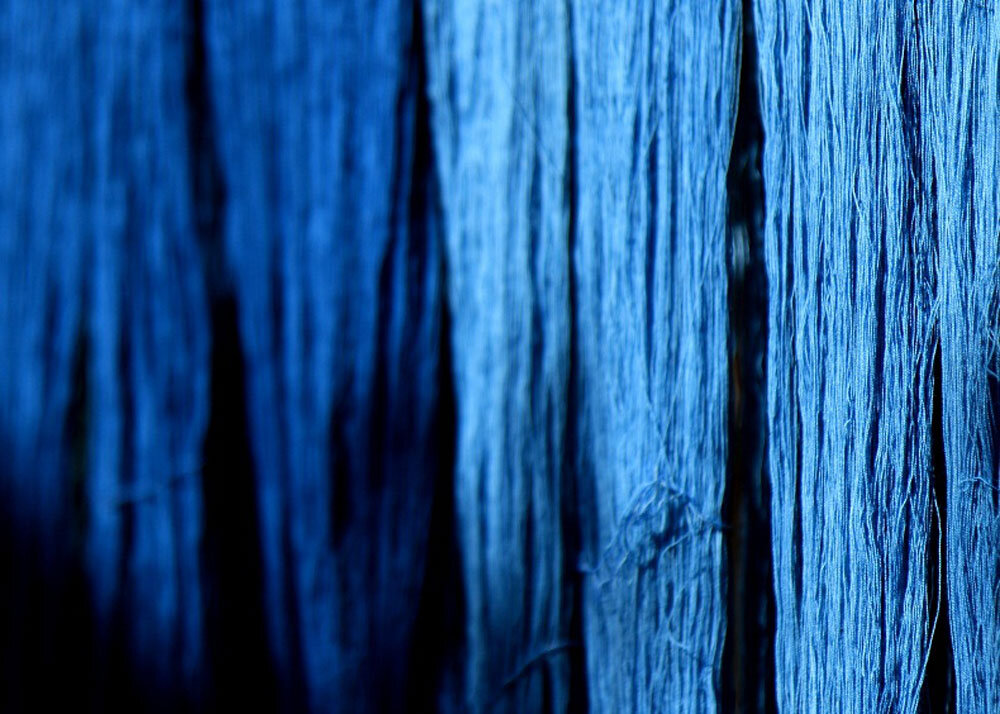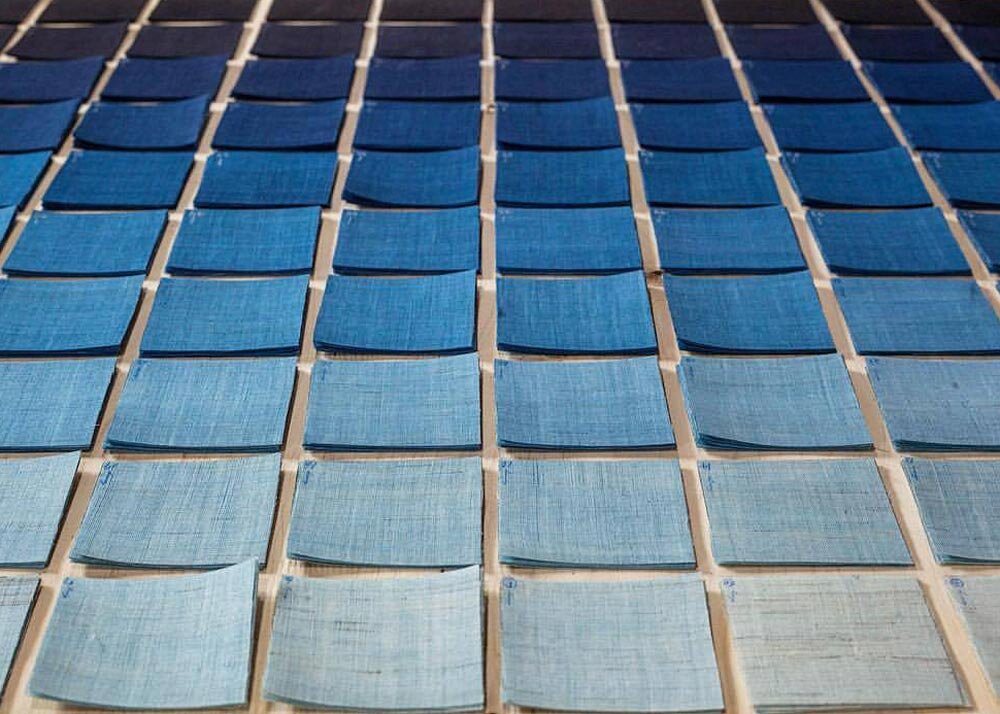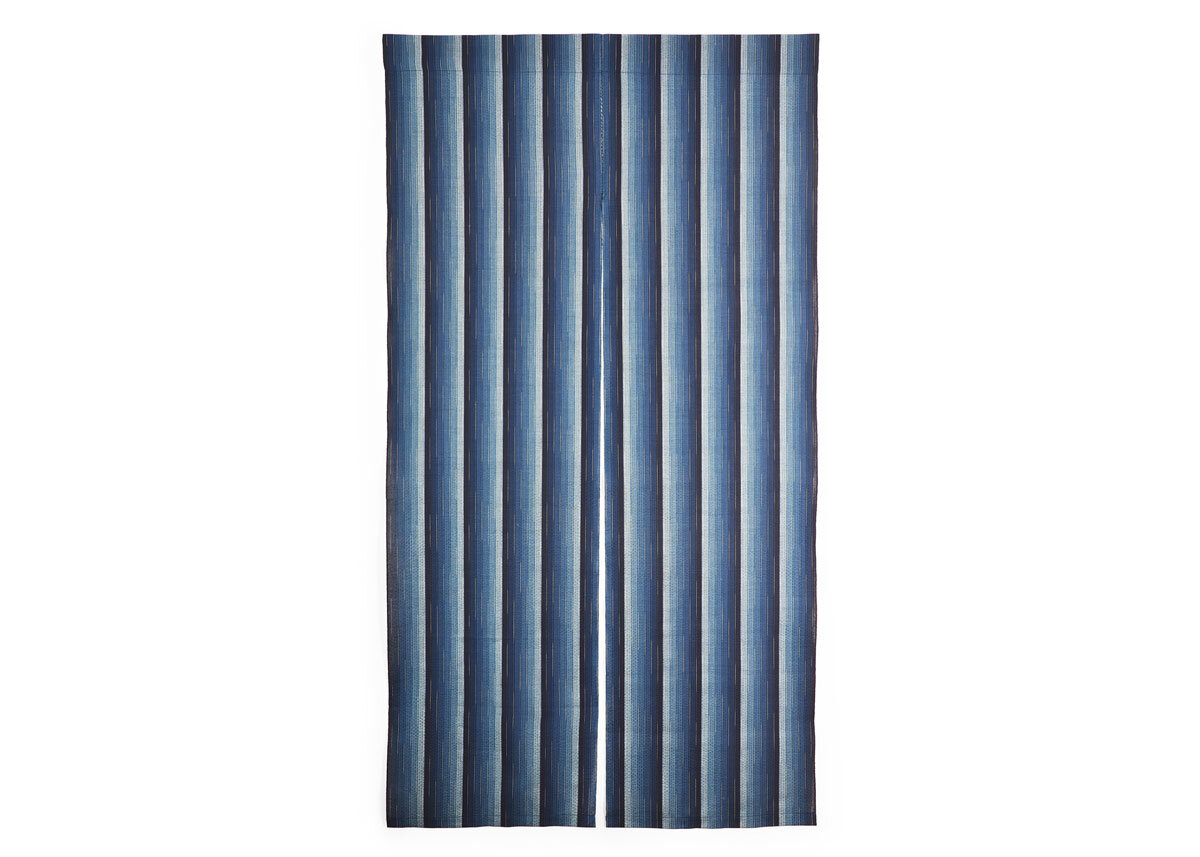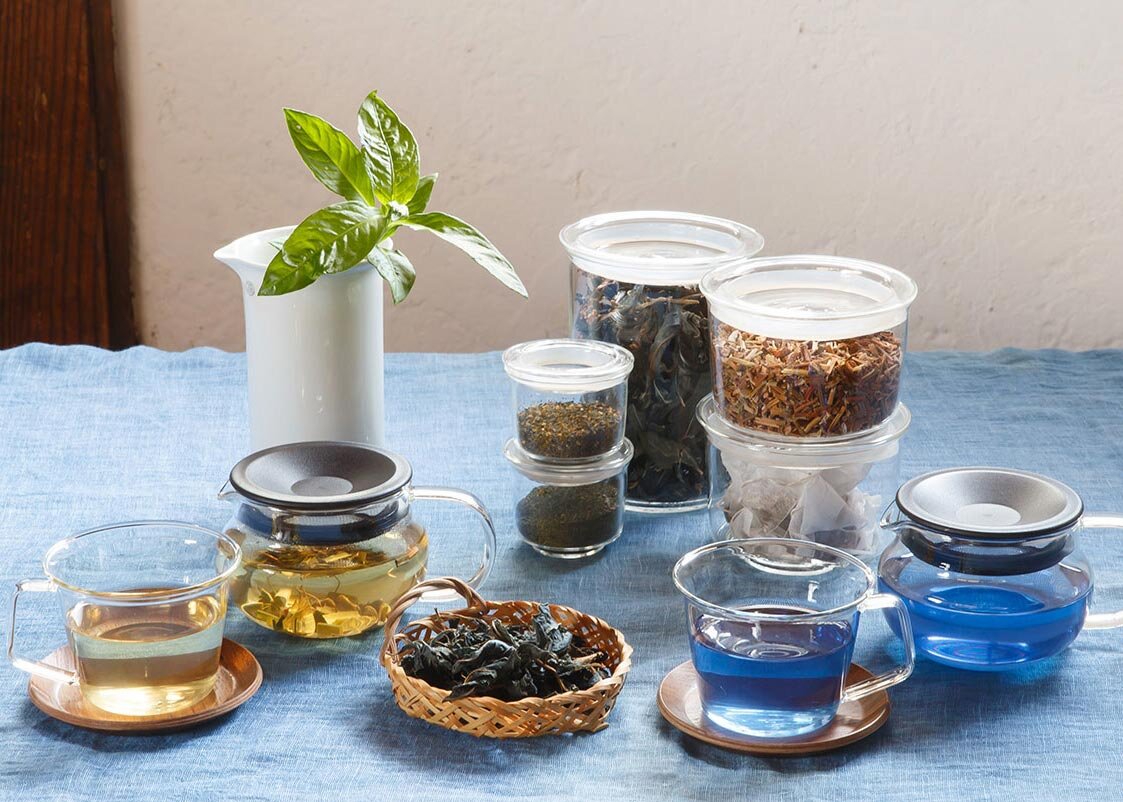7 Things You Should Know About Japanese Indigo Dye
by Nupur Singh | CRAFT
Men of Money by Utagawa Kuniyoshi / Shibori Dyed Kosode Kimono, Met Museum
Literally soaked into the fabric of Japan’s cultural history, the art of indigo dyeing is as richly diverse and fascinating now as it was when it was first developed centuries ago.
Although it is an ancient method, the process of aizome, or indigo dyeing, continues to have a deep influence and importance on fashion even today. In this guide to Japanese indigo dye, we’ll show you how it’s made, when it originated in Japan, why it’s important, and where to buy the best indigo dyed products!
1. The History of Japanese Indigo Dye
Indigo-Dyed Sashiko Jacket, Early 19th Century, Met Museum
In Japan, indigo dyeing is known as aizome, and its popularity dates back to the Edo period (1603-1868), when brighter colors were reserved for the higher social classes. The lower classes were also banned from wearing silk which left cotton as the only option, so aizome and cotton made a durable team. By the 17th century, Indigo had become widely regarded not just for its robust color, but also its antibacterial and insect-repellent properties.
© Tottori Prefectural Museum, Fish by Kichiemon Okamura, 1975
Known as an effective odor-preventing dye, aizome clothing also provided skin relief for people suffering from eczema. The samurai wore indigo clothing to prevent wound infections, and firefighters favored indigo fabric for its flame retardant properties.
Shibori Dyed Kosode Kimono, Met Museum
During this period, not only clothing, but also households were dyed with indigo, including kimono, haori (find out more about haori kimono jackets), hand towels, bedding and crockery. Indigo became synonymous with Japanese culture and quickly became the very fabric that unified the community under one color.
Indigo-dyed Cotton Yukata, Indianapolis Museum
Today the dye has become associated with ideologies of high quality and craftsmanship. The beauty and durability of Japanese indigo dye has made it inextricably linked to products from acclaimed Japanese denim to contemporary fashion. A creation as fascinating as it is beloved, there’s a lot more to indigo dye than meets the eye.
2. How to Make Indigo Dye?
Indigo Plant
This farm-to-closet color has been harvested through many plants throughout the world, but in Japan, the blue dye comes from the plant Persicaria Tintoria. By the 17th century, indigo artisans had perfected their hues and mastered the art of deep blue aizome dyeing.
The creation of indigo dyed articles involves two main processes, the first being the creation of the dye itself, and the second, the dyeing of the fabrics. The indigo plant actually has green leaves, and it takes about a year to produce the characteristic blue color. Many methods of extraction exist, but the most common technique in Japan involves the fermentation of the leaves.
© Discover Tokushima, Awa Indigo Dye
The process begins with sun-drying the indigo leaves followed by an intensive fermentation to make sukumo. Next, the concentrated dye component is integrated with lime, Iye other substances in a dyeing vat and re-fermented before it is ready to use.
The actual process of Aizome dyeing can create many different shades of blue depending on the level of fermentation, the product in use, and the dyeing time. The solution itself appears black, but once the fabric dries it takes on a unique shade of blue due to exposure to air. Depending on the number of dips, the colour of the blue deepens, with each shade given a unique name. Aijiro indigo is the lightest shade closest to white, while noukon indigo is the darkest shade closest to black. A great example of an indigo landmark is the Tokyo Skytree, the body of which is aijiro colored.
Ryoya Takashima of vegan blog peacefulcuisine.com, explores the process of creating organic indigo dye in the video below!
3. Where in Japan is Indigo Made?
© Discover Tokushima, Shijira Weaving
With modern irrigation indigo can grow in almost every prefecture of Japan today; however, originally the highest yield came from the Shikoku region, where indigo dye production was first born in the tenth century. Indigo grew throughout Shikoku but flourished mainly in towns around Tokushima and Kagawa. The climate of Tokushima, its rich soil, and abundant water from the Yoshino River created ideal conditions for the harvest of the Indigo plant.
Natural Indigo-Dye Noren Curtains, Available at Japan Objects Store
Aizumi and Mima are two famed towns in Tokushima prefecture of the Shikoku region with a thriving 300-year-old history as the flourishing centre of Indigo dyeing. Tokushima Indigo is also known as Awa Indigo after the region's older name. As the indigo trade grew, Tokushima became an influential, wealthy commercial center, a beacon of indigo heritage, crafts and traditions.
4. Where to Experience Indigo Dying in Japan?
Tokyo-based website Best Living Japan offers classes about Itajime Shibori with aizome traditional handicraft using a shape-resist technique to produce different fabric patterns. In this shape resist dyeing session, each student uses a 2’ x 4’ piece of linen which can be later used as a table runner, scarf, artwork, or made into apparel.
In preparation, here are 5 Things You Should Know About Japanese Shibori Dyeing!
At the Nihon Minka-en Kawasaki, also known as Kawasaki Municipal Japanese Folk House, you can experience the indigo dyeing process in the various classes offered by the Traditional Indigo Dyeing Workshop. A beginner-friendly 90 minutes involves dyeing a plain handkerchief, plan bandana or a tote bag. Or you can bring your fabric like a shirt, a cloth or a hand towel and dye it at the store.
© Wanariya
Wanariya in Taito, Tokyo, offers workshops where customers can experience traditional Japanese indigo dyeing in 45 minute classes. Even children aged four and above can take part in some of the courses. You have various options to choose from with each focusing on dyeing different articles including towels, handkerchiefs, pouches, stoles, totes, canvas, t-shirts and caps.
© Discover Tokushima, Awashouai-shijiraori
The Higeta Indigo Dyeing House was founded in Mashiko, Tochigi, over 200 years ago. Managed by Tadashi Higeta, a 9th generation master dyer and weaver live on the premises in an Edo-era thatched-roof building built in the mid-1800s. Here you can explore the 72 dyeing vats producing 32 different shades of indigo. At a souvenir shop inside the complex, they sell stoles, scarves, wallets, and handkerchiefs. The items are a little bit pricey as all articles are handmade. Though the workshops here are conducted in Japanese, the dyeing house visit is a must and entry is free, although prior reservation is recommended.
© Explore Okayama, Jeans Street
Kojima, a small town in Okayama, is today home to some of the most highly regarded manufacturers of denim jeans in the world. In fact the city is so synonymous with denim production that it’s home to Kojima Jeans Street, which as the name suggests is a street dedicated entirely to jeans. This renovated shopping district is home to jeans producers, dyers, cafes, denim lovers and practically everything a jeans fanatic could need.
5. How to Use Indigo Dye?
Indigo-Dye Cotton Scarf, Available at Japan Objects Store
Japanese indigo dye is prized for both its visual beauty as well as its more practical qualities. The dye is used with clothing for both these reasons. Fashion designers and jean makers also love indigo dye because unlike cheaply produced chemical dyes, this natural plant dye gets better with age. Instead of fading out to a tired, worn-out look, indigo’s organic qualities mean that it ages like leather.
© Indigo Studio, Aizome Sekken
The antibacterial quality of indigo also make it a unique foundation for skin and beauty products like soaps. An excellent example of some of the best indigo soap is Aizome Sekken a handmade soap crafted from the indigo-rich area of Tokushima. Essentially however the purposes of this dye are only limited by one’s imagination.
6. Where to Buy Japanese Indigo Products?
Natural Indigo-Dye Noren Curtains, Available at Japan Objects Store
These traditional Japanese curtains, or noren available at Japan Objects Store, create a sense of harmony and balance when hung between rooms, on windows or in doorways. They are ethically hand-dyed with natural indigo dye and are woven together by the rare Awa Shoai Shijira Ori technique, reflecting the noren's exquisite crepe texture. If you want to know more, check out Noren Guide: How to Choose the Best Japanese Curtain.
Indigo-Dye Cotton Scarf, Available at Japan Objects Store
Accessorizing with multipurpose natural indigo scarves is a great way of bringing a bit of Japan to your closet. They can double as a head wrap or around the neck across seasons. These iconic Japanese Indigo scarves in cotton are both hypoallergenic and eco-friendly, created sustainably for maximum comfort. Available at Japan Objects Store with free shipping.
Edible Indigo
© Aiakane
The medicinal properties of Indigo are the very reason why it has been consumed since ancient times. Indigo is an antibacterial known to strengthen the immune system and fight common colds. It can be extracted by powdering the plant's root, flower and even seeds. Superfood indigo is consumed in teas, salts, and even raw powdered indigo sprinkled on sweets, spices, and smoothies. Check out Aiakane for more.
Indigo in Skincare Products
Indigo Cream, available at Amazon
Indigo has long been used as a hair care product in soaps and creams due to its protective qualities.The plant's extract is considered to comfort irritated skin and indigo creams are used for eczema and psoriasis, providing anti-inflammatory relief. The iconic Tatcha cosmetics have a whole skincare range dedicated to products made from the indigo plant: cream, body butter and hand cream.
AIZOME Bedding
© AIZOME
The organically dyed fabric of AIZOME bedding acts as an anti-inflammatory, soothing agent when in contact with the skin. These sustainable bedsheets feel like a dream and do not aggravate eczema. Currently, it is the only company using plant-based indigo dye for bed linen. High thread count with sateen weave is used to achieve the final smooth fabric, promoting sound sleep and well-being.
Buaisou ethnically cultivates the raw Indigo from the ground up and then dyes and designs its collection of products which range from clothes to ceramics to furnishings to book covers. Opened in 2015 in Kamiita-Cho in Tokushima prefecture, BUAISOU's future goal is to grow their cotton and Indigo and create new weaves.
© Okura
Located in the backstreets of Daikanyama, Okura is a traditional and elegant Japanese-style loft turned store and is home to a wide selection of men's and women's clothing. Think kimono-inspired tops, rustic denim jeans and avant-garde designer pieces, and expect everything from the classic to the modern.
© Pure Blue Japan, Indigo-Dyed Jeans
Pure Blue Japan is an inner-city outlet with a passion for everything about indigo. It's the ultimate denim house in Tokyo with shirts, jacket, jeans and everything in between. Another store also located in Kojima, denim's hometown.
If you were to choose just one Indigo-dye store in the ancient capital, make it this one in Kyoto. Aizenkobo Indigo Place is a combination of a store and workshop, it's not only a great place to pick up beautiful gifts but an educational experience to get a little hands-on about the Indigo dyeing experience. The store owners are delighted to chat about everything to do with Aizome and its unique products, so if you want to learn more about Indigo dyeing, this is the place to go!
7. How to Find Out More about Japanese Indigo?
Get your hands on this guidebook Indigo: Cultivate, Dye, Create that takes you through the many gorgeous possibilities of dyeing with indigo: from growing plants, cold dyeing and creating intricate indigo patterns. Ideal for both beginners and experienced dyers.
If you’d like to know more about Japanese textiles, then check out What is Sashiko? 7 Things to Know About Japanese Embroidery.
JO SELECTS offers helpful suggestions, and genuine recommendations for high-quality, authentic Japanese art & design. We know how difficult it is to search for Japanese artists, artisans and designers on the vast internet, so we came up with this lifestyle guide to highlight the most inspiring Japanese artworks, designs and products for your everyday needs.
All product suggestions are independently selected and individually reviewed. We try our best to update information, but all prices and availability are subject to change. As an Amazon Associate, Japan Objects earns from qualifying purchases.






















LIFESTYLE | July 28, 2023